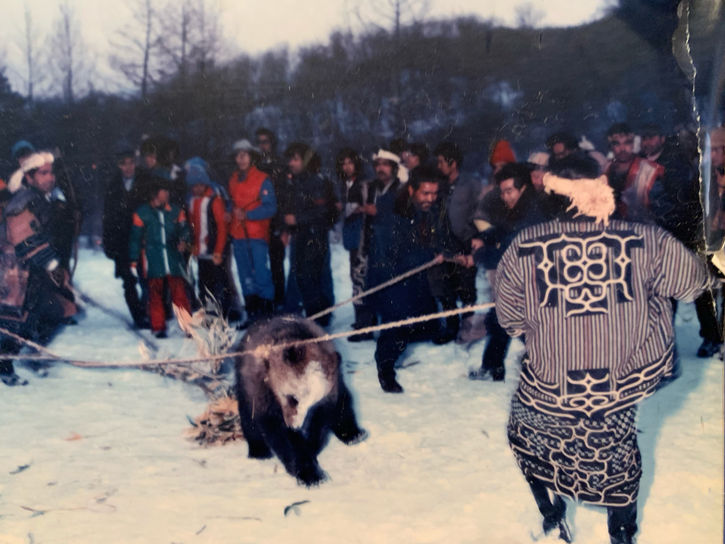SHINGO YOSHIDA
Seeking Hidden
© 1999 - 2024 Studio SHINGO YOSHIDA. All rights reserved.
Kamuy yukar
FILM | PHOTOGRAPHY
Location: Rishiri Island, Yamunai-Rive, Hokkaido, JAPAN
Date: 28-31 August 2020
Duration: 4 min 30 sec
Format: 4K ProRes 422 HQ
ヤムナイ沢は、利尻山の斜面に位置する小さな沢で、
“日本最北の越年雪渓”が残る場所として知られています。
「ヤムナイ(yam-nay)」とはアイヌ語で「冷たい川」を意味します。
近年は気候変動の影響により、土石流対策としてコンクリートの治山構造物が設置されています。
Yamunai Stream (Rishiri Island, Hokkaido)
Yamunai Stream flows along the slopes of Mt. Rishiri and is known for containing the northernmost perennial snow patch in Japan.
“Yamunai” comes from the Ainu words yam (cold) and nay (stream or river).
In recent years, due to the effects of climate change, concrete erosion control structures have been installed to prevent debris flows caused by heavy rainfall and rapid snowmelt.
• 大空に描いたコタン: 大空に描いたコタン』──カムイユカㇻ(神謡)をもとにした歌語り
アンナホレホレホレ
わたしの村よ
なんと懐かしいことか
そのために
二度の食事、三度の食事
やがて
わたしは外へ出て
どうにかこうにか
這うように進み
ようやく
見上げてみると――
雲の表面に
本当に
わたしたちの村が
わたしたちの大地が
ふたつの絵として
みっつの絵として
そこに描かれていた
清らかな沙流川の流れには
小ジカ・大ジカの群れが現れ
魚たちは
水面を押し合うようにひしめいていた
走り回る者
魚を獲る者
木の実を掘る者
川岸や山裾には
ヤナギ、ハンノキ、ヨシが茂り
それを見たわたしは
爽快な気持ちになった
English Translation
• The Village Drawn in the Sky: The Village Drawn in the Sky” — a sung recitation based on the Kamuy Yukar (Ainu sacred epic).
Annahore hore hore...
My village—how dear, how nostalgic.
For its sake, two meals, then three.
At last, I made my way outside,
crawling slowly, dragging myself along.
And finally, when I looked up—
on the surface of the clouds,
truly,
our village,
our land,
were drawn there—
once, twice, three times—like paintings.
In the clear flow of the Saru River,
herds of small and large deer passed by,
and fish surged and crowded along the shimmering surface.
Some ran through the land,
some caught fish,
others dug for nuts.
Along the riverbanks and at the mountain’s base,
willows, alders, and reeds grew thickly—
and seeing all of it,
my heart filled with joy.
English:
Ainu Policy Reform Act (2019)
In 2019, Japan passed a new law officially recognizing the Ainu as an Indigenous people for the first time.
The legislation promotes cultural preservation, tourism, and traditional fishing practices, while prohibiting discrimination and aiming to build a more inclusive society.
It also acknowledges the historical hardships the Ainu endured during modernization and emphasizes the importance of preserving their cultural identity and pride.
Sources:
Nibutani Ainu Culture Museum
Kayano Shigeru Nibutani Ainu Archive
Français:
Loi sur les Aïnous (2019)
En 2019, le Japon a adopté une nouvelle loi reconnaissant officiellement les Aïnous comme peuple autochtone pour la première fois.
Ce texte vise à promouvoir la culture aïnou, le tourisme et les pratiques de pêche traditionnelles, tout en interdisant toute forme de discrimination et en encourageant une société inclusive.
La loi reconnaît également les souffrances historiques subies par les Aïnous au cours de la modernisation et souligne l’importance de préserver leur fierté et leur identité culturelle.
Sources :
Musée de la culture aïnou de Nibutani
Archives Aïnous de Shigeru Kayano à Nibutani
日本語:
アイヌ新法(2019年)
2019年、アイヌ民族を日本で初めて「先住民族」と明記したアイヌ新法が成立しました。
文化振興や観光支援、伝統的漁法の規制緩和などが盛り込まれ、差別の禁止と多様な共生社会の実現を目的としています。
近代化の中でアイヌ民族が受けた歴史的苦難への配慮、そして民族としての誇りの継承が強調されました。
資料:
二風谷アイヌ文化博物館
萱野茂二風谷アイヌ資料館
























